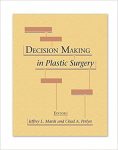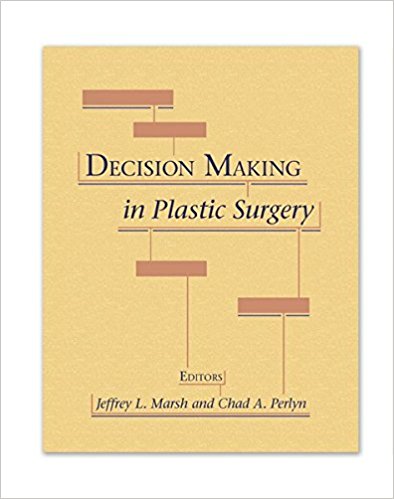 Editors: Jeffrey L. Marsh, MD; Chad A. Perlyn, MD
Editors: Jeffrey L. Marsh, MD; Chad A. Perlyn, MD
Publisher: Quality Medical Publishing – 340 pages
Book Review by: Nano Khilnani
It might be simplistic to state that the aphorism “if you fail to plan, you plan to fail” applies to plastic and reconstructive surgery as well, but that I believe is more or less the point the Foreword author Dr. Peter Crandall makes at the beginning of this unusual book.
Dr. Crandall writes:
“The key to success in plastic surgery is the decision-making process that precedes any surgical intervention. Careful planning is essential to avoiding complications and achieving excellent outcomes. That is why this new book Decision-Making in Plastic Surgery, edited by Drs. Jeffrey March and Chad Perlyn is such a welcome addition to the literature.”
“It supplies us with the tools for assessing a wide range of aesthetic and reconstructive problems. The unique format composed of algorithms and supporting text, provides the readers with a virtual roadmap for navigating these frequently complex conditions and arriving at time-tested solutions.”
So what is unusual about this book, compared to others? What makes it stand apart from others on the subject? It is that each chapter presents an algorithm. For those who are not familiar with this term, we found this definition by Googling it:
“An algorithm produces the same output information given the same input information, and several short algorithms can be combined to perform complex tasks such as writing a computer program. A cookbook recipe, a diagnosis, a problem solving routine, is some common examples of simple algorithms.”
We did not find the source of this definition in our Google search. In short an algorithm is a reliable, systematic method of producing the same outcome, or more accurately, the same output, when the same information is input. An algorithm lessens the adverse effects of emotions that influence human judgment that lead to bad decisions.
Full-page, detailed outlines of algorithms are provided for each of this book’s 137 chapters, and at the beginning of each Section, a small (2.5” x 3.)” image of the algorithm key is shown on the bottom left. The algorithm key is the same on the beginning page of every Section. But the detailed full-page algorithm is different for each chapter because the surgical procedures and medical treatments vary for each case.
The 102 contributors to the contents this book, including the editors named above are specialists in several fields within plastic, reconstructive, and other types of surgery. They are mainly from the United States, as well as from seven other countries – Canada, Israel, Italy, Japan, New Zealand, Taiwan, and the United Kingdom.
They are practicing surgeons and / or professors of aesthetic facial surgery, craniofacial surgery, neurosurgery, ophthalmic surgery, oral and maxillofacial surgery, orthopedic surgery, otolaryngology and head and neck surgery, and other fields.
They have authored the 137 chapters that constitute this book of extensive coverage. To give you a broad overview of the contents, we name below the titles of the three main Parts, the Sections, and Sub-sections into which the chapters are allocated.
The beginning page of each Part presents the titles of the Sections within, and the beginning page of each Section presents the titles of each Subsection and/or each chapter.
- Part I. Fundamentals
- Wound Management: chapters 1 through 12
- Part II. Reconstructive Surgery
- Skin: chapters 13 through 17
- Head and Neck: chapters 18 through 58
- Congenital Anomalies: chapters 18 through 34
- Dentoskeletal Malocclusion: chapters 35 through 37
- Craniofacial Trauma: chapters 38 through 45
- Neoplasms and Reconstruction: chapters 46 through 58
- Breast and Trunk: chapters 59 through 71
- Upper Extremity: chapters 72 through 101
- Congenital and Acquired Pediatric Abnormalities: chapters 72 through 78
- Acute Hand Trauma: chapters 79 through 91
- Special Problems: chapters 92 through 101
- Lower Extremity: chapters 102 through 109
- Part III. Aesthetic Surgery
- Skin: chapters 110 through 112
- Scalp, Brow, and Periorbital Area: chapters 113 through 116
- Face: chapters 117 through 121
- Nose: chapters 122 through 124
- Breast: chapters 125 through 129
- Body Contouring: chapters 130 through 133
- Massive Weight Loss: chapters 134 through 137
The chapters in this book are very brief. In most cases, each chapter consists of just two pages. The page on the left side presents a textual outline of the problem, and the right-side page presents the outline of the analysis of the problem, and the solution to it in algorithmic format.
The contents of this book are very systematically organized for easy reference to each problem presented therein and for quick retrieval of information on the solution to each problem encountered. The algorithmic format of this book gives it a huge advantage over others, and brings it to the forefront of books on surgery in general, and on aesthetic, plastic and reconstructive surgery in particular.
Editors:
Jeffrey L. Marsh, MD is Clinical Professor of Surgery at St. Louis University School of Medicine; Director of Pediatric Plastic Surgery and Director of Cleft Lip / Palate and Craniofacial Deformities Center at St. John’s Mercy Children’s Hospital in St. Louis, Missouri.
Chad A. Perlyn, MD, PhD is Attending Physician in the Division of Plastic Surgery at Miami Children’s Hospital; and Clinical Associate Professor of Surgery in the Department of Surgery at Florida International University College of Medicine in Miami, Florida







